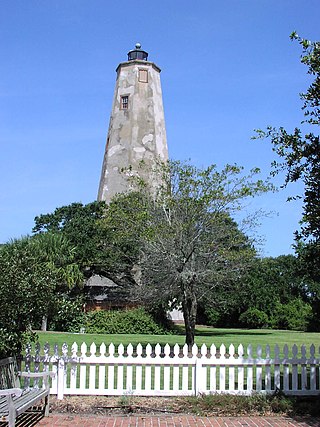
A lighthouse is a tower, building, or other type of physical structure designed to emit light from a system of lamps and lenses and to serve as a beacon for navigational aid for maritime pilots at sea or on inland waterways.

A lightvessel, or lightship, is a ship that acts as a lighthouse. They are used in waters that are too deep or otherwise unsuitable for lighthouse construction. Although some records exist of fire beacons being placed on ships in Roman times, the first modern lightvessel was located off the Nore sandbank at the mouth of the River Thames in London, England, and placed there by its inventor Robert Hamblin in 1734. Lightships have since become largely obsolete; being largely replaced by lighthouses as construction techniques advanced, and by large automated navigation buoys.

A screw-pile lighthouse is a lighthouse which stands on piles that are screwed into sandy or muddy sea or river bottoms. The first screw-pile lighthouse to begin construction was built by the blind Irish engineer Alexander Mitchell. Construction began in 1838 at the mouth of the Thames and was known as the Maplin Sands lighthouse, and first lit in 1841. However, though its construction began later, the Wyre Light in Fleetwood, Lancashire, was the first to be lit.

Bald Head Lighthouse, known as Old Baldy, is the oldest lighthouse still standing in North Carolina. It is the second of three lighthouses that have been built on Bald Head Island since the 18th century to help guide ships past the dangerous shoals at the mouth of the Cape Fear river.

The station named Nantucket or Nantucket Shoals was served by a number of lightvessels that marked the hazardous Nantucket Shoals south of Nantucket Island. The vessels, given numbers as their "name," had the station name painted on their hulls when assigned to the station. Several ships have been assigned to the Nantucket Shoals lightship station and have been called Nantucket. It was common for a lightship to be reassigned and then have the new station name painted on the hull. The Nantucket station was a significant US lightship station for transatlantic voyages. Established in 1854, the station marked the limits of the dangerous Nantucket Shoals. She was the last lightship seen by vessels departing the United States, as well as the first beacon seen on approach. The position was 40 miles (64 km) southeast of Nantucket Island, the farthest lightship in North America, and experienced clockwise rotary tidal currents.
The Dames Point Light marked an 8-foot-deep (2.4 m) shoal at a sharp bend in the St. Johns River in Florida that was a danger to ships heading to or from Jacksonville.

The unmanned reef lights of the Florida Keys were navigational aids erected near the Florida Keys between 1921 and 1935.

A Texas Tower lighthouse is a structure which is similar to an off-shore oil platform. Seven of these structures were built in the 1960s off the shores of the United States. Automation started in the late 1970s, which led to the obsolescence of the housing built for the keepers which resulted in such a large structure. Three of the towers were dismantled over time due to deteriorating structural conditions among other problems, while another one was destroyed in a ship collision. The last Texas Tower was deactivated in 2016 having served for over half a century. Today only three of the former lights remain.
The Janes Island Light was a screw-pile lighthouse located near Crisfield in the U.S. state of Maryland. Twice destroyed by ice, it was replaced in 1935 with an automated beacon.

The York Spit Light was a lighthouse located at the mouth of the York River in the Chesapeake Bay, marking a long shoal paralleling the main channel into the river.

The Wyre Light was a 40-foot (12 m) tall iron screw-pile lighthouse marking the navigation channel to the town of Fleetwood, Lancashire, England.
The Pulau Pisang Lighthouse is a lighthouse located on the highest point of Pulau Pisang, an island in the Strait of Malacca 15 kilometres from Pontian Kechil, Johor, Malaysia.

The Cape Rachado Lighthouse is a lighthouse located in Cape Rachado, also known as Tanjung Tuan in Malay, in Alor Gajah District, Malacca, Malaysia. The lighthouse is believed to be the oldest in the country, its history allegedly dating back to Portuguese rule of Malacca during the 16th century, although the present structure is obviously a 19th-century construction.
Undan Island Lighthouse is a lighthouse on the summit of the uninhabited islet of Undan Island, located 25 kilometres (16 mi) off the coast of mainland Malacca in Malaysia.

The Brandywine Shoal Light is a lighthouse on the north side of the ship channel in Delaware Bay on the east coast of the United States, west of Cape May, Cape May County, New Jersey, United States. It was the site of the first screw-pile lighthouse in the United States.

Diamond Shoal Light is an inactive offshore lighthouse marking Diamond Shoals off Cape Hatteras.

The Peshtigo Reef Light is a lighthouse in Marinette County, Wisconsin, United States, offshore in lower Green Bay. Constructed in 1936 to replace a lightship, it remains in service.

The Ship Shoal Light is a screw-pile lighthouse located in the Gulf of Mexico southwest of the Isles Dernieres off the coast of Louisiana. It is currently abandoned.

The Point Abino Light Tower is a lighthouse on the rocky north shore of Lake Erie at the southern tip of Point Abino peninsula west of Crystal Beach, Ontario, Canada. The Greek Revival white square tower with red accents is attached to the fog alarm building, and a lighthouse keeper's residence is located on the shore to the north.
















